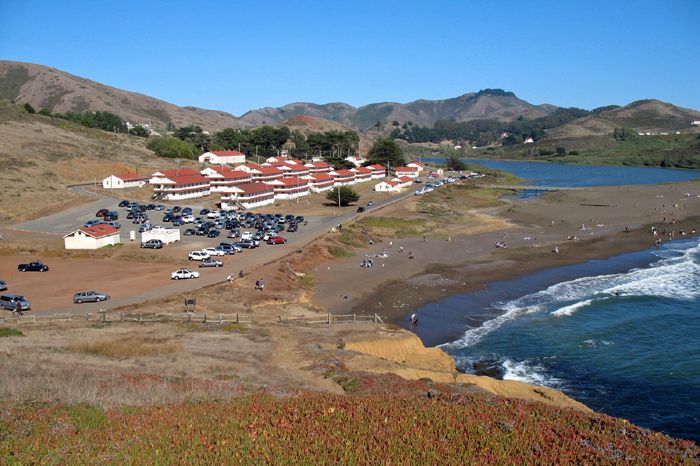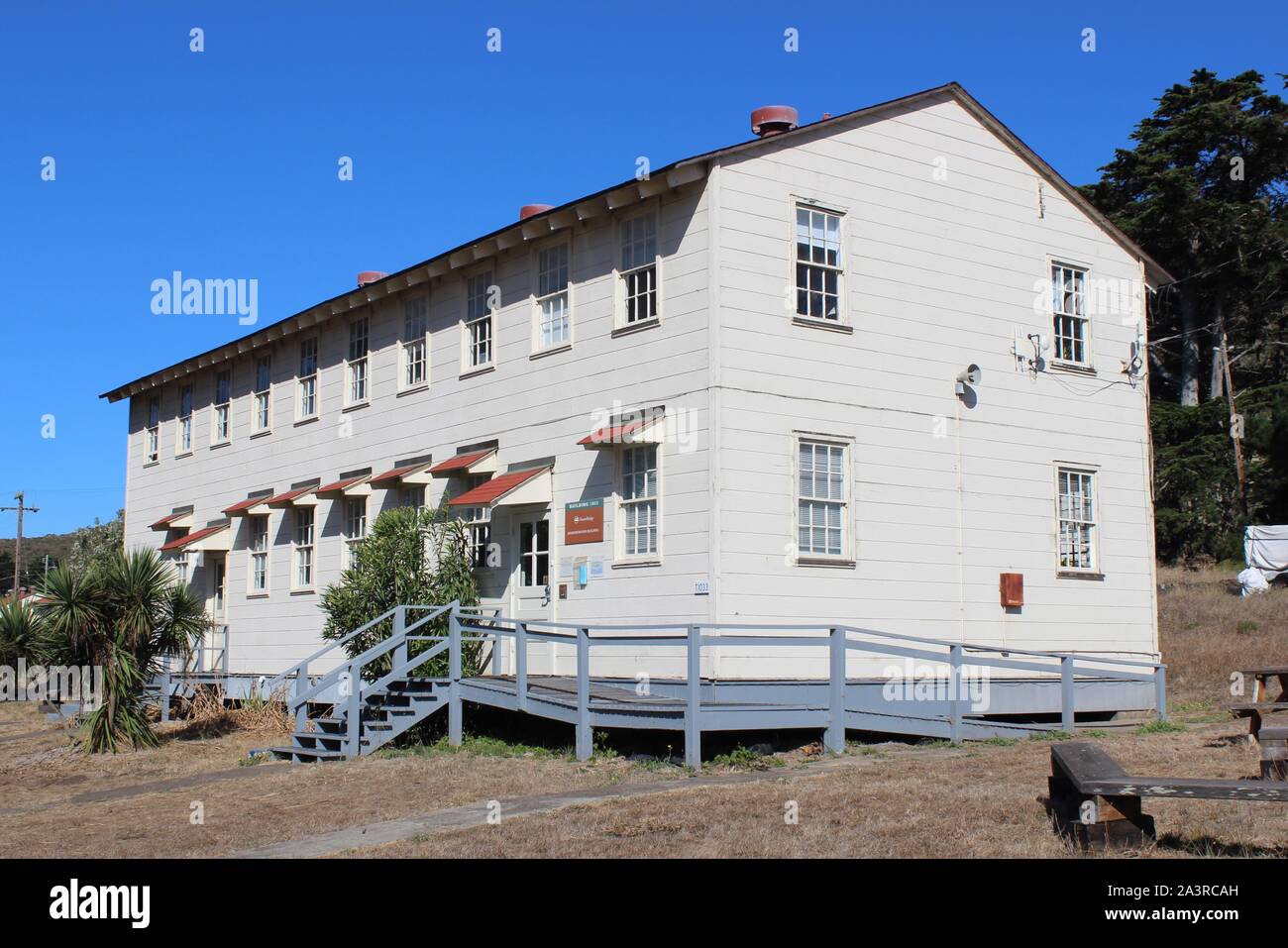
Fort Cronkhite: Where Coastal Defenses Met Crashing Waves and Cold War Ghosts
The wind whips through the Marin Headlands, carrying the scent of eucalyptus and salt spray across the rugged bluffs. Below, the Pacific Ocean relentlessly crashes against Rodeo Beach, its waves a constant, powerful rhythm. Hikers and cyclists traverse winding trails, their eyes drawn to the majestic Golden Gate Bridge in the distance or the swirling patterns of a hawk riding the thermals overhead. It’s a landscape of breathtaking natural beauty, a jewel in the crown of the Golden Gate National Recreation Area (GGNRA).
But beneath this tranquility, etched into the very fabric of the land, lies a profound and often unsettling history. Here, nestled within a valley carved by Rodeo Creek, stands Fort Cronkhite – a spectral village of weathered barracks, imposing concrete bunkers, and silent parade grounds. It’s a place where the echoes of two World Wars and the chilling specter of the Cold War still whisper on the wind, a poignant testament to an era when this serene stretch of coastline was a vital bastion in the defense of San Francisco Bay.
A Bastion Born of Fear: World War II

The story of Fort Cronkhite begins in earnest with the dark clouds gathering over Europe and Asia in the late 1930s. As the world plunged into World War II, the United States recognized the vulnerability of its coastal cities, particularly vital strategic ports like San Francisco. The attack on Pearl Harbor in December 1941 solidified these fears, igniting a national urgency to fortify the nation’s shores against potential invasion.
Fort Cronkhite was established in 1941 as a crucial component of the extensive "Harbor Defenses of San Francisco." It wasn’t designed to house the massive 16-inch disappearing guns of nearby Battery Townsley or Battery Mendell, but rather to provide essential support: housing for thousands of soldiers, administrative facilities, mess halls, and training grounds for the coastal artillery units manning the formidable defenses of the Golden Gate. Its strategic location, just north of the Golden Gate, made it an ideal staging point.
Imagine the scene in the early 1940s: this quiet valley, once home to dairy farms and grazing cattle, transformed overnight into a bustling military encampment. Rows upon rows of identical, utilitarian wooden barracks sprang up, their clapboard walls now weathered by decades of salt spray and fog. The air would have hummed with activity – the clatter of boots on the parade ground, the distant boom of artillery practice, the shouts of drill sergeants, the camaraderie and tension of young men preparing for an unknown threat.
Life at Fort Cronkhite during WWII was undoubtedly a mix of routine and readiness. Soldiers trained rigorously, mastering the complex artillery systems designed to protect the Golden Gate from enemy ships. While no enemy attack ever materialized directly on San Francisco, the constant state of alert was real. The fort served its purpose, a silent sentinel, its very presence a deterrent, and a symbol of America’s resolve.
From Naval Guns to Nuclear Missiles: The Cold War Era
As World War II drew to a close, the nature of warfare underwent a dramatic transformation. The advent of the atomic bomb and the rise of the Soviet Union ushered in the Cold War, a new era of global tension dominated by the threat of nuclear annihilation and supersonic aircraft. The coastal defenses designed to repel battleships became obsolete almost overnight.
Fort Cronkhite, however, found a new and equally vital role. From the mid-1950s through the early 1970s, it became a key administrative and support facility for the Nike Missile Program. The iconic Nike Ajax and later Nike Hercules missiles, designed to intercept Soviet bombers carrying nuclear payloads, dotted the landscape around major U.S. cities. The Marin Headlands, with its commanding views and strategic proximity to San Francisco, became a critical part of this defensive shield.
While the actual launch sites, such as the well-preserved SF-88 Nike Missile Site nearby, were the visible symbols of this new defense, Fort Cronkhite provided the essential logistical and human infrastructure. Soldiers and officers who operated these complex missile systems lived and worked within its confines. The purpose of the fort shifted from defending against a naval invasion to guarding against an aerial attack, a far more terrifying and instantaneous threat.

The Cold War period at Fort Cronkhite was characterized by a different kind of vigilance. The constant hum of generators, the glow of radar screens, and the silent, ever-present readiness of missile crews replaced the rumble of heavy artillery. The threat was invisible, high in the sky, and potentially catastrophic. For nearly two decades, Fort Cronkhite stood as a silent witness to the most tense period in modern history, a physical embodiment of the doctrine of mutually assured destruction.
The Transition: From Military Base to National Park
By the early 1970s, the Cold War doctrine shifted once more. Intercontinental ballistic missiles (ICBMs) rendered localized anti-aircraft missile systems largely obsolete. Fort Cronkhite, along with many other military installations, was decommissioned. Its strategic purpose had passed.
However, its story was far from over. In a visionary move, the lands of the Marin Headlands, including Fort Cronkhite, were incorporated into the newly established Golden Gate National Recreation Area (GGNRA) in 1972. This act transformed a former military stronghold into one of the largest and most visited urban national parks in the world, a testament to the power of conservation and public access.
The transition wasn’t without its challenges. What do you do with a sprawling military base, complete with hundreds of buildings and infrastructure, in the heart of a pristine natural landscape? The GGNRA embarked on a careful process of preservation, adaptation, and restoration. Many of the barracks were repurposed, becoming dormitories for educational programs, offices for park staff, and housing for artists and researchers. Some structures were removed to restore natural habitats, while others were left to decay naturally, becoming part of the landscape’s historical tapestry.
Fort Cronkhite Today: A Living Museum and Natural Sanctuary
Today, Fort Cronkhite offers visitors a unique and compelling blend of history, nature, and recreation. The rows of barracks, though weathered, still stand, evoking a powerful sense of the past. The parade ground, once a place of strict military drills, is now a grassy expanse where visitors might picnic or children play.
One of the most striking aspects of Fort Cronkhite is the way nature has begun to reclaim parts of its man-made past. Rusting metal fixtures are slowly consumed by salt and air, concrete bunkers are softened by lichen and moss, and native plants creep around the edges of former foundations. This interplay between the enduring human footprint and the relentless power of the natural world creates a profound sense of temporal layering.
Visitors can explore the area on foot or by bike, following trails that weave through the fort and out onto the dramatic bluffs. Rodeo Beach, just a stone’s throw from the barracks, is a popular spot for surfers, beachcombers, and birdwatchers. Its unique black sand, formed from serpentine rock, adds to its allure.
A short hike up from the fort leads to the remnants of Battery Townsley, a colossal concrete bunker that once housed 16-inch naval guns. While the guns are long gone, the sheer scale of the structure is awe-inspiring, offering panoramic views of the Pacific and a stark reminder of the immense engineering effort involved in coastal defense. Similarly, the nearby SF-88 Nike Missile Site stands as a meticulously preserved testament to the Cold War, offering guided tours that bring the chilling history of that era vividly to life.
Fort Cronkhite also serves as a hub for environmental education and scientific research. The Marine Mammal Center, a renowned hospital for sick and injured marine mammals, is located just across Rodeo Lagoon, attracting visitors keen to learn about marine conservation. The Headlands Center for the Arts, housed in some of the repurposed fort buildings, offers residencies for artists, adding a vibrant cultural dimension to this historic site.
Echoes and Reflections
Walking through Fort Cronkhite is an experience that transcends a simple stroll. It’s an invitation to reflect on the immense shifts in human history, the constant evolution of warfare, and the enduring power of nature to reclaim and transform. The wind that whispers through the barracks carries not just the scent of the sea, but also the phantom echoes of soldiers’ lives, of drills and duties, of fear and vigilance.
It’s a place that asks us to consider what we defend, why we defend it, and what legacy those defenses leave behind. Fort Cronkhite stands as a powerful symbol: a former bastion of military might now dedicated to recreation, education, and the preservation of both natural and historical heritage. It reminds us that even the most formidable structures are ultimately subject to the relentless march of time, and that sometimes, the greatest strength lies not in weaponry, but in the quiet resilience of the land itself. In the Marin Headlands, Fort Cronkhite is not just a collection of old buildings; it is a living, breathing chapter in America’s story, open for all to explore and ponder.


